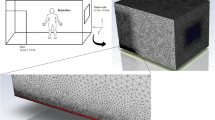Abstract
Performances and efficiencies of displacement ventilation (DV) and partial ventilation (PV) for industrial halls of different configurations as well as the heat and mass transports within the industrial halls were numerically investigated. Three levels of Rayleigh number (5.8×1010, 1.0×1012 and 2.1×1012) and two values of source contaminant flux (5 mg/s and 50 mg/s) were considered. The inlet Reynolds numbers were 2×104, 5×104, 1.5×105 and 4.5×105 for DV and 5×105, 1×106, 2×106 and 4×106 for PV, respectively. From the results, it is concluded that the above parameters have very complex impacts on the conjugated heat and mass transports. From points of view of acceptable indoor air quality and ventilation efficiency, PV at Re=1×106 with side-located sources and 65% of the supply air extracted through floor level outlets is the best choice when Ra=5.8×1010. However, DVs at Re=5×104 and Re=1.5×105 with center-located sources and floor-mounted air suppliers are the best choices for Ra=1.0×1012 and Ra=2.1×1012, respectively. When source contaminant flux reaches 50 mg/s, local extraction as a supplement of general ventilation is recommended. The results can be a first approximation to 3D numerical investigation and preliminary ventilation system design guidelines for high-rise industrial halls.
Similar content being viewed by others
References
LÜ Yang, YOSHINO H, TAKAKI R, KURIHARA R, MOCHIDA A, YONEKURA H. Effect of floor level slit exhaust ventilation system on distribution of house dust [J]. Journal of Central South University,2012, 19(3): 696–702.
ZHANG R, JING J, TAO J, HSU S C, WANF G, CAO J, LEE C S L, ZHU L, CHEN Z, ZHAO Y, SHEN Z. Chemical characterization and source apportionment of PM2.5 in Beijing: Seasonal perspective [J]. Atmospheric Chemistry and Physics, 2013, 13: 7053–7074.
CHENG Yuan-da, NIU Jian-lei, GAO Nai-ping. Stratified air distribution systems in a large lecture theatre: A numerical method to optimize thermal comfort and maximize energy saving [J]. Energy and Buildings, 2012, 55: 515–525.
BOTTCHER R W, BAUGHMAN G R, DRIGGERS L B. Temperature stratification in broiler houses and the effect of ceiling fan [J]. Applied Engineering in Agriculture, 1988, 4(1): 66–71.
SAÏD M N A, MACDONALD R A, DURRANT G C. Measurement of thermal stratification in large single-cell buildings [J]. Energy and Buildings, 1996, 24(2): 105–115.
HEISELBERG P, MURAKAMI S, ROULET C A. Ventilation of large spaces in buildings: Analysis and prediction techniques [R]. Aalborg: Aalborg University, 1998.
CALAY R K, BORRESEN B A, HOLDØ A E. Selective ventilation in large enclosures [J]. Energy and Buildings, 2000, 32: 281–289.
ARENS A D. Evaluation of displacement ventilation for use in highceiling facilities [D]. Cambridge: Massachusetts Institute of Technology, 2000.
YE Xiao-jiang, LIAN Zhi-wei. Air distribution numerical simulating of isothermal jet with interference parameters in large space [J]. Simulation Modelling Practice and Theory, 2005, 13(2): 139–155.
HUANG Chen, ZOU Zhi-jun, LI Mei-ling. Measurements of indoor thermal environment and energy analysis in a large space building in typical seasons [J]. Building and Environment, 2007, 42(5): 1869–1877.
HUANG C, WANG X. Discussion of design method and optimization on airflow distribution in a large-space building with stratified air-conditioning system [J]. ASHRAE Transactions, 2009, 115(2): 345–349.
WANG Yong, WONG K K L, DU Hong-mei. Design configuration for a higher efficiency air conditioning system in large space building [J]. Energy and Buildings, 2014, 72: 167–176.
NIEMELÄ R, KOSKELA H, ENGSTRÖM K. Stratification of welding fumes and grinding particles in a large factory hall equipped with displacement [J]. The Annals of Occupational Hygiene, 2001, 45(6): 467–471.
CAPUTO A C, PELAGAGGE P M. Upgrading mixed ventilation systems in industrial conditioning [J]. Applied Thermal Engineering, 2009, 29(14/15): 3204–3211.
TANASIC N, JANKES G, SKISTAD H. CFD analysis and airflow measurements to approach large industrial halls energy efficiency: A case study of a cardboard mill hall [J]. Energy and Buildings, 2011, 43(6): 1200–1206.
WANG Han-qing, HUANG Chun-hua, LIU Di, ZHAO Fu-yun, SUN Hai-bo, WANG Feng-feng, LI Can, KOU Guang-xiao, YE Ming-qiang. Fume transports in a high rise industrial welding hall with displacement ventilation system and individual ventilation units [J]. Building and Environment, 2012, 52: 119–128.
ZHAO Fu-yun, LIU Di, WANG Han-qing. History recovery and source identification of multiple gaseous contaminants releasing with thermal effects in an indoor environment [J]. International Journal of Heat and Mass Transfer, 2012, 55(1/2/3): 422–435.
CHEN Qing-yan, GLICKSMAN L, YUAN Xiao-xiong. Performance evaluation and development of design guidelines for displacement ventilation [R]. Cambridge: Massachusetts Institute of Technology, 1999.
ZHAO Fu-yun, RANK E, LIU Di, WANG Han-qing, DING Yu-long. Dual steady transports of heat and moisture in a vent enclosure with all round states of ambient air [J]. International Journal of Heat and Mass Transfer, 2012, 55(23/24): 6979–6993.
ZHAO Fu-yun, LIU Di, WANG Han-qing, KOU Guang-xiao, TANG Guang-fa. Free heat and mass transfer in a porous enclosure with side vents [J]. Drying Technology, 2011, 29(1): 91–104.
LIU Di, ZHAO Fu-yun, WANG Han-qing. Passive heat and moisture removal from a natural vented enclosure with a massive wall [J]. Energy, 2011, 36(5): 2867–2882.
van TREECK C, RANK E. Dimensional reduction of 3D building models using graph theory and its application in building energy simulation [J]. Engineering with Computers, 2007, 23(2): 109–122.
GBZ 2.1-2007. Occupational exposure limits for hazardous agents in the workplace [S]. (in Chinese)
Author information
Authors and Affiliations
Corresponding author
Additional information
Foundation item: Project(2011BAJ03B07) supported by National Twelve Five-year Science and Technology Support Program of China; Project supported by the China Scholarship Council; Project(51276057, 51376198) supported by the National Natural Science Foundation of China; Project(CX2014B064) supported by Hunan Provincial Innovation Foundation for Postgraduate, China
Rights and permissions
About this article
Cite this article
Wang, Ff., Liu, Zq., van Treeck, C. et al. Heat and hazardous contaminant transports in ventilated high-rise industrial halls. J. Cent. South Univ. 22, 2106–2118 (2015). https://doi.org/10.1007/s11771-015-2735-z
Received:
Accepted:
Published:
Issue Date:
DOI: https://doi.org/10.1007/s11771-015-2735-z



